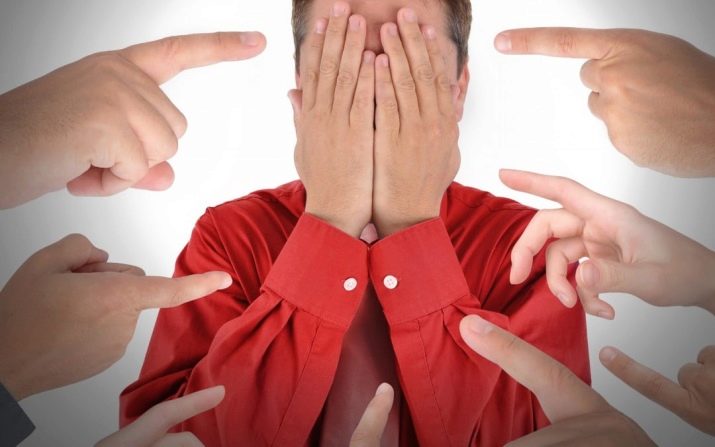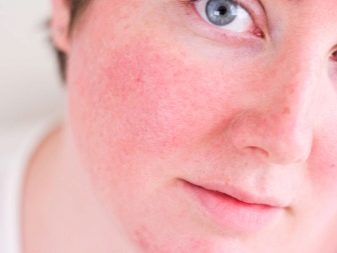Everyone can blush - from awkwardness, shame, from embarrassment or indignation. But there are people who can blush just like that, suddenly their face "flashes", which causes others to be perplexed. This is a fairly common disorder called erythrophobia.
Description
Erythrophobia is called pathological fear caused by the prospect of blushing in public in public. Oddly enough, but this is exactly what happens in the end. There are other names for the fear of flushing of the face, it is called blushing syndrome or idiopathic erythema. Fear can not be called irrational, like most phobias, because Erythrophobia have reason to be afraid of facial redness - they have such a predisposition.
There are people who have increased excitability of the sympathetic part of the autonomic nervous system, and because of this, there is often a flow of blood to the skin of the face, hands, neck. But there is no fear for the time being, and only when a person (usually a teenager) begins to understand that his redness causes questions from others, does he begin to fear repeated episodes, however, in no way can he affect the likelihood of their occurrence.
Alone, when no one sees the patient, fear usually does not arise. Anyway, fear is closely connected with the social environment, the public, with the reluctance to become a laughing stock or face uncomfortable questions from other people.
Redness of the face (hyperemia) may be uniform or uneven (spotted).
Existing statistics states that at least 0.2% of the planet’s population suffers from erythrophobia. But it is difficult to calculate the exact amount, because not all erythrophobes turn for help to medical institutions.
Erythrophobia can significantly affect a person's life - communication is difficult, the patient can hardly make contacts, and sometimes makes a decision to isolate herself from others. Eritrofoby can not engage in public activities, speak to an audience, to teach. Many professions that are close to them in spirit, are desirable, become unavailable - fear dictates its own conditions.
One of the most famous Erythrophobic of our time is a Hollywood actress, owner of several Oscars, including the role of Bridget Jones, Renee Zellweger. The actress often visits a psychotherapist, and her hyperemia, often asymmetrical, has already become part of her image. She learned to live quite peacefully with her. But this example is rather an exception. Most people with blushing syndrome do not manage to come to terms with their peculiarity, and yet there is a pathological fear.
Erythrophobia is one of the phobic mental disorders officially recognized by medicine and included in the International Classification of Diseases.
Causes
The human face is supplied with blood more intensively than most other parts of the body. And it is not just that nature intended it. On the face there is an impressive amount of small facial muscles, which are fixed with one end directly into the layers of the skin. Mimic muscles are almost always in motion, and therefore they need more blood for normal functioning. The grid of facial blood vessels is very developed, despite the fact that the vessels themselves are rather small.
So that the skin on the face is not red or purple all the time, due to the physiological characteristics of this part of the body, there is a small layer of interstitial fluid in the subcutaneous fatty tissue, which reduces the color intensity if the vessels expand. But until the end to mask the flow of blood, it can not, and therefore it is common for a person to blush when blood rushes to his face: during physical exertion, running, fast walking, during sexual discharge, during heat, coldand also with strong emotions, for example, when it is shameful, when a person is very confused, very worried, etc. This mechanism is peculiar to all people without exception.
Erythrophobes have a slightly different organization of the nervous system. The sympathetic section is excited more and faster, and it is not at all necessary that the person be in the above circumstances. To blush a person with erythrophobia may just be when a person is completely calm.
As soon as a teenager begins to realize that he is "not so" that he has such a peculiarity, negative expectations increase - he is in almost constant tension, because he knows that treacherous redness can spill over the face at the most inappropriate moment. There is a fear of this phenomenon, which is accompanied by the release of adrenaline. Adrenaline, in turn, excites the nervous system even more, and what erythrophobic feared so much is actually happening. Over time, hyperemia episodes become more frequent, and fear also increases.
And it is difficult to say that in this case it is primary - the face turns red because the patient is afraid that the face will turn red. This is the mystery of the human psyche.
Symptoms
The phobia is manifested quite straightforwardly - frequent reddening of the skin of the face. Some patients with blushing syndrome claim that all skin reddens equally, others note the so-called geographical hyperemia - redness occurs with large and medium spots, resembling the geographical outlines of the continents. In some cases, hyperemia is limited only to the face, but there are those who have their neck and décolleté area involved in the process. Often, erythrophobes claim that they experience a clear sensation of hot flashes to the face in an attack, and this is fully justified - blood flow can actually cause a feeling of warmth.
Eritrofoby very quickly lose confidence in their abilities and adequate self-esteem. They turn into embarrassed, intimidated individuals, fearful and anxious. Despite their desires and dreams, they have to choose professions in which they will not have to deal with people. They find it difficult to make love and friendship.
The more daily life suffers, the more its quality decreases, the more closed and disturbing people become subject to blushing syndrome. Often, the consequences arising from it are added to the original problem: the patient becomes a convinced social phobia, begins to suffer from depressions, each subsequent of which becomes more protracted and more severe than the previous one.
It is not excluded addiction to alcohol, narcotic substances, as well as suicidal thoughts, which the erythrophobe at any moment may try to realize.
Treatment
At home, coping with the blushing syndrome is impossible. A person definitely needs professional help. To get it, you can contact a psychotherapist or psychiatrist. To begin, you will need to be examined by a gynecologist (if it's a woman), to exclude early menopause and preclimacteric changes, you may also need the opinions of a dermatologist, endocrinologist and therapist.
If it is confirmed that the patient as a whole is healthy, an individual therapeutic scheme will be developed, which may include several directions.
Operation
To date, the most encouraging method of therapy is recognized as surgical treatment. The operation is called sympathectomy. Its effectiveness is estimated at 94-97%. That is how many patients after the intervention completely get rid of their problems.
But it should be noted that such high efficiency is observed only for those who have reddening captures the entire face area. If the face turns red, the effectiveness of the operation does not exceed 50%.
The operation is carried out not for everyone. It will not do in diseases of the respiratory system and heart failure. The task of surgeons is to reach the sympathetic trunk through two miniature incisions under the arms. To do this, they introduce a small video camera and in this endoscopic method, doctors manage to get an image on the screen. The sympathetic trunk is partially blocked or destroyed.
Most often, experts try not to destroy, but to install special “plugs” - clips.
After interfering with the work of the nervous system during and after surgery, certain side effects may occur: sweating in the area of the body, legs increases, when eating spicy food, sweating also occurs, palms become more dry, and the heart rate decreases slightly. However, most often these phenomena are not as significant and unpleasant for an erythrophobic than the problem that led him to the operating table.
Psychological techniques
Psychotherapy for erythrophobia is necessarily combined with patient education. relaxation techniques, deep relaxation. The task of the psychotherapist is to make the person understand that he can remain calm, and this will necessarily give a positive result. The patient is offered new installations that refute the shamefulness or depravity of his features, in other words, they teach him to live with this feature. The psychotherapist not only talks about how to properly treat the problem, but also teaches erythrophobia auto-training techniques, breathing exercises - this is exactly what will help, if necessary, quickly pull yourself together and prevent excitement.
Group sessions proved to be very good, but at the same time individual work with a specialist was shown. Hypnotherapy is often used, as well as methods of gradual immersion in stress situations, allowing the patient, under the guidance of a psychotherapist, to re-experience situations in which he recently experienced shame, nightmare and horror.
This is not to say that psychotherapy can cure erythrophobe completely. No, the cause of facial flushing persists, however, the patient's attitude towards the problem changes, and therefore the frequency and intensity of the attacks decrease. A person gets the opportunity to communicate with others, his self-esteem rises.
Medications
Among the medicines there is no universal medicine for this phobia, there is no magic pill or shots that would help solve the problem. However, often the psychotherapist considers it necessary to accompany the occupation with medicines. Use antidepressants to help maintain a positive mood, as well as drugs from the group of beta-blockers, which slightly reduce the heart rate. This has an amazing effect - the connection between stress, heartbeat and reddening of the skin of the face and neck is broken.
It is necessary to understand that antidepressants, and even more so beta-blockers have a large list of solid side effects, many of them are generally contraindicated, and therefore they try to use drug therapy for eritrophobia only in the most extreme cases when psychotherapy alone does not work, but surgical treatment is considered inappropriate.




















